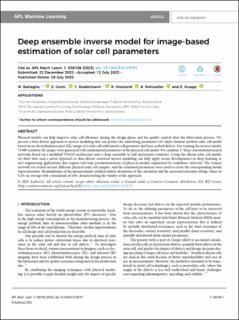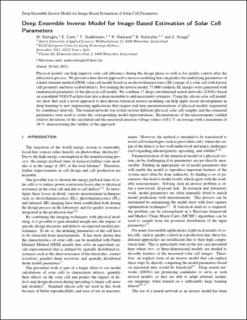Please use this identifier to cite or link to this item:
https://doi.org/10.21256/zhaw-28346Full metadata record
| DC Field | Value | Language |
|---|---|---|
| dc.contributor.author | Battaglia, Mattia | - |
| dc.contributor.author | Comi, Ennio | - |
| dc.contributor.author | Stadelmann, Thilo | - |
| dc.contributor.author | Hiestand, Roman | - |
| dc.contributor.author | Ruhstaller, Beat | - |
| dc.contributor.author | Knapp, Evelyne | - |
| dc.date.accessioned | 2023-07-27T09:08:57Z | - |
| dc.date.available | 2023-07-27T09:08:57Z | - |
| dc.date.issued | 2023 | - |
| dc.identifier.issn | 2770-9019 | de_CH |
| dc.identifier.uri | https://digitalcollection.zhaw.ch/handle/11475/28346 | - |
| dc.description.abstract | Physical models can help improve solar cell efficiency during the design phase as well as for quality control after the fabrication process. We present a data-driven approach to inverse modeling that can predict the underlying parameters of a finite element method (FEM) solar cell model based on an electroluminescence (EL) image of a solar cell with known cell geometry and laser scribed defects. For training the inverse model, 75,000 synthetic EL images were generated with randomized parameters of the physical cell model. We combine 17 deep convolutional neural networks (CNNs) based on a modified VGG19 architecture into a deep ensemble to add uncertainty estimates. Using the silicon solar cell model, we show that such a novel approach to data-driven statistical inverse modeling can help apply recent developments in deep learning to new engineering applications that require real-time parameterizations of physical models augmented by confidence intervals. The trained network was tested on four different physical solar cell samples and the estimated parameters were used to create the corresponding model representations. Resimulations of the measurements yielded relative deviations of the calculated and the measured junction voltage values of 0.2 \% on average with a maximum of 10 %, demonstrating the validity of the approach. | de_CH |
| dc.language.iso | en | de_CH |
| dc.publisher | AIP Publishing | de_CH |
| dc.relation.ispartof | APL Machine Learning | de_CH |
| dc.rights | http://creativecommons.org/licenses/by/4.0/ | de_CH |
| dc.subject | Machine learning | de_CH |
| dc.subject | PV | de_CH |
| dc.subject | CNN | de_CH |
| dc.subject | Inverse modelling | de_CH |
| dc.subject | Finite element method | de_CH |
| dc.subject | Parameter estimation | de_CH |
| dc.subject | Imaging | de_CH |
| dc.subject.ddc | 006: Spezielle Computerverfahren | de_CH |
| dc.subject.ddc | 621.3: Elektro-, Kommunikations-, Steuerungs- und Regelungstechnik | de_CH |
| dc.title | Deep ensemble inverse model for image-based estimation of solar cell parameters | de_CH |
| dc.type | Beitrag in wissenschaftlicher Zeitschrift | de_CH |
| dcterms.type | Text | de_CH |
| zhaw.departement | School of Engineering | de_CH |
| zhaw.organisationalunit | Centre for Artificial Intelligence (CAI) | de_CH |
| zhaw.organisationalunit | Institute of Computational Physics (ICP) | de_CH |
| dc.identifier.doi | 10.1063/5.0139707 | de_CH |
| dc.identifier.doi | 10.21256/zhaw-28346 | - |
| zhaw.funding.eu | No | de_CH |
| zhaw.issue | 3 | de_CH |
| zhaw.originated.zhaw | Yes | de_CH |
| zhaw.pages.start | 036108 | de_CH |
| zhaw.publication.status | publishedVersion | de_CH |
| zhaw.volume | 1 | de_CH |
| zhaw.publication.review | Peer review (Publikation) | de_CH |
| zhaw.webfeed | Datalab | de_CH |
| zhaw.webfeed | Machine Perception and Cognition | de_CH |
| zhaw.webfeed | Multiphysics Modeling | de_CH |
| zhaw.webfeed | Photonics | de_CH |
| zhaw.webfeed | Photovoltaik | de_CH |
| zhaw.webfeed | ZHAW digital | de_CH |
| zhaw.webfeed | ZHAW sustainable | de_CH |
| zhaw.author.additional | No | de_CH |
| zhaw.display.portrait | Yes | de_CH |
| Appears in collections: | Publikationen School of Engineering | |
Files in This Item:
| File | Description | Size | Format | |
|---|---|---|---|---|
| 2023_Battaglia-etal_Deep-ensemble-inverse-model-image-based-estimations_VoR.pdf | Published Version | 3.71 MB | Adobe PDF |  View/Open |
| 2023_Battaglia-etal_Deep-ensemble-inverse-model-image-based-estimation.pdf | Accepted Version | 1.03 MB | Adobe PDF |  View/Open |
Show simple item record
Battaglia, M., Comi, E., Stadelmann, T., Hiestand, R., Ruhstaller, B., & Knapp, E. (2023). Deep ensemble inverse model for image-based estimation of solar cell parameters. APL Machine Learning, 1(3), 36108. https://doi.org/10.1063/5.0139707
Battaglia, M. et al. (2023) ‘Deep ensemble inverse model for image-based estimation of solar cell parameters’, APL Machine Learning, 1(3), p. 036108. Available at: https://doi.org/10.1063/5.0139707.
M. Battaglia, E. Comi, T. Stadelmann, R. Hiestand, B. Ruhstaller, and E. Knapp, “Deep ensemble inverse model for image-based estimation of solar cell parameters,” APL Machine Learning, vol. 1, no. 3, p. 036108, 2023, doi: 10.1063/5.0139707.
BATTAGLIA, Mattia, Ennio COMI, Thilo STADELMANN, Roman HIESTAND, Beat RUHSTALLER und Evelyne KNAPP, 2023. Deep ensemble inverse model for image-based estimation of solar cell parameters. APL Machine Learning. 2023. Bd. 1, Nr. 3, S. 036108. DOI 10.1063/5.0139707
Battaglia, Mattia, Ennio Comi, Thilo Stadelmann, Roman Hiestand, Beat Ruhstaller, and Evelyne Knapp. 2023. “Deep Ensemble Inverse Model for Image-Based Estimation of Solar Cell Parameters.” APL Machine Learning 1 (3): 36108. https://doi.org/10.1063/5.0139707.
Battaglia, Mattia, et al. “Deep Ensemble Inverse Model for Image-Based Estimation of Solar Cell Parameters.” APL Machine Learning, vol. 1, no. 3, 2023, p. 36108, https://doi.org/10.1063/5.0139707.
Items in DSpace are protected by copyright, with all rights reserved, unless otherwise indicated.